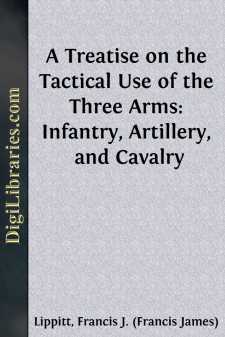Categories
- Antiques & Collectibles 13
- Architecture 36
- Art 48
- Bibles 22
- Biography & Autobiography 813
- Body, Mind & Spirit 142
- Business & Economics 28
- Children's Books 17
- Children's Fiction 14
- Computers 4
- Cooking 94
- Crafts & Hobbies 4
- Drama 346
- Education 46
- Family & Relationships 57
- Fiction 11829
- Games 19
- Gardening 17
- Health & Fitness 34
- History 1377
- House & Home 1
- Humor 147
- Juvenile Fiction 1873
- Juvenile Nonfiction 202
- Language Arts & Disciplines 88
- Law 16
- Literary Collections 686
- Literary Criticism 179
- Mathematics 13
- Medical 41
- Music 40
- Nature 179
- Non-Classifiable 1768
- Performing Arts 7
- Periodicals 1453
- Philosophy 64
- Photography 2
- Poetry 896
- Political Science 203
- Psychology 42
- Reference 154
- Religion 513
- Science 126
- Self-Help 84
- Social Science 81
- Sports & Recreation 34
- Study Aids 3
- Technology & Engineering 59
- Transportation 23
- Travel 463
- True Crime 29
A Treatise on the Tactical Use of the Three Arms: Infantry, Artillery, and Cavalry
Categories:
Description:
Excerpt
Infantry attacks with its fire, or with the bayonet. Which of these is the more effective?
1. The object of an attack is to destroy or capture the hostile force, or, at least, to drive it from the field.
Capturing the enemy, or driving him from the field, cannot usually be effected by merely firing upon him.
True, a mere fire at a distance may finally destroy him. But an insuperable objection to this mode of attack is, that while we are killing or disabling his men, he is killing or disabling as many of our own.
2. If we fire from behind cover, our loss may be comparatively small. But, in that case, the enemy will never remain for any length of time exposed to our fire. He will either attack and rout us from our cover, or retire. And even if he did neither, his actual and complete destruction, capture, or rout, would still require an attack with the bayonet.
3. It follows that the proper mode of attack by infantry on infantry is with the bayonet.
The Russian Suwarrow's victories and reputation were won chiefly by his fierce bayonet attacks, which often effected great results, in spite of his ignorance of the art of war.
4. But there are exceptional cases where infantry may properly use only its fire; as—
(1.) When acting as a support to artillery, it should rarely, if ever, leave its position to use the bayonet; thereby endangering the safety of the guns which it is its first duty to guard. Its function, in this case, being purely defensive, it should act by its fire alone.
(2.) Against a line of skirmishers deployed, a well-directed fire will usually be sufficiently effective.
(3.) In mountain warfare, its only practicable mode of attack will sometimes be by its fire.
5. When both sides are equally exposed, the actual attack with the bayonet should not be preceded by a distant musketry fire; for, as in that case, our loss will generally be equal to the enemy's, this fire will give us no superiority in the charge, and the loss we have sustained will be therefore entirely thrown away.
6. Nevertheless, our actual attack should be prepared, when possible, by the infliction of such a loss on the enemy as will make him inferior to us at the decisive moment. In war, the object is not to test the comparative courage of the combatants, but to beat the enemy. We must never, therefore, when it can be avoided, fight him on equal terms; and so, never close with him without such a superiority in numbers, position, or spirit, as will make the chances decidedly in our favor. If, without exposing ourselves to much loss, we can inflict a considerable loss upon him, we shall render him inferior to us, both by the number of his men we have disabled, and by the demoralization thereby caused in his ranks.
7. This preparatory loss can be most effectually inflicted by the fire of artillery; as, from its great superiority of range, it can suffer but little, meanwhile, from the enemy's infantry fire. Our attacking infantry are thus enabled to keep out of the range of the fire of the infantry they are to attack, till the moment of advancing to close.
8. When we have no artillery disposable for the purpose, the preparatory effect may be produced by a well-sustained fire of infantry, provided it can find a sheltered position to deliver it from; or, by the fire of a heavy line of skirmishers....


